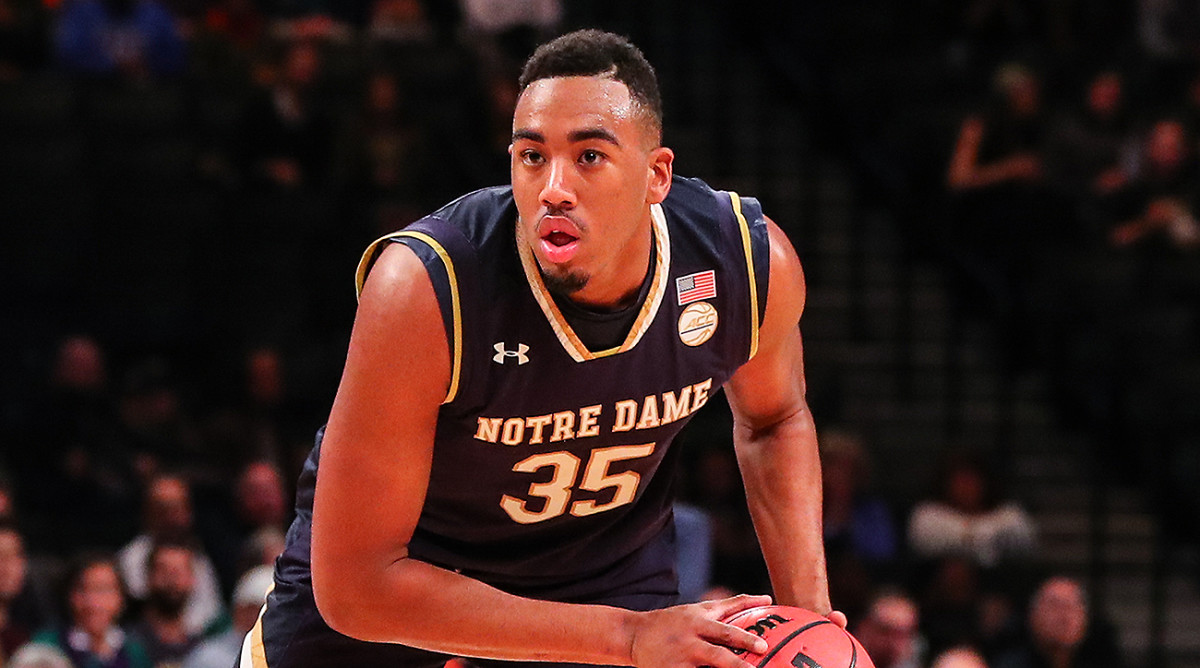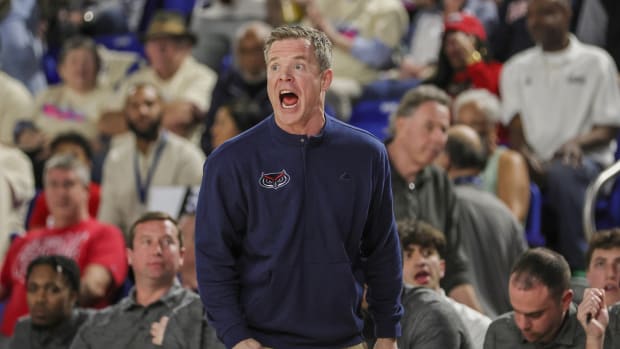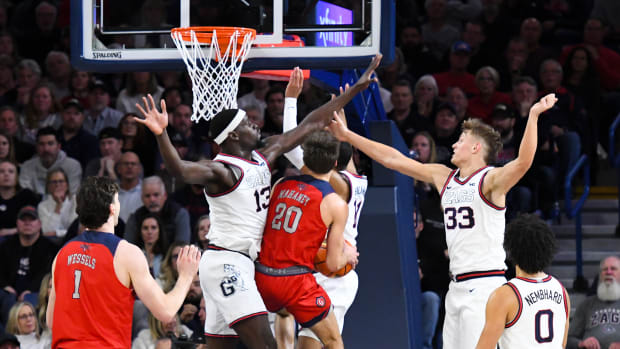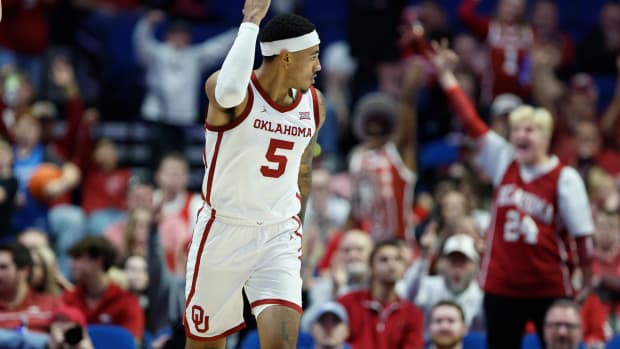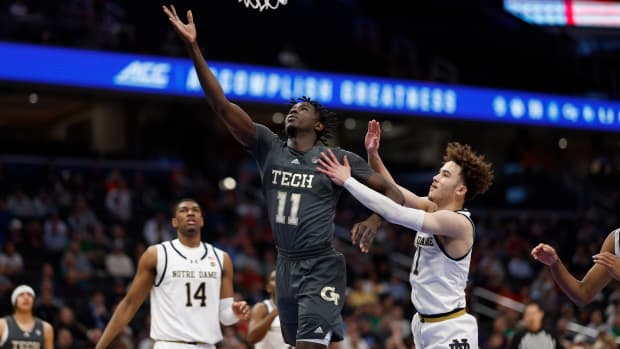Undersized and underrated, Bonzie Colson has become Notre Dame's star
In July 2013, Nike’s AAU basketball website, D1Circuit.com, published a story that was atypical for recruiting coverage at the time: a breakdown of the top Player Efficiency Ratings in its Elite Youth Basketball League, which had recently begun tracking advanced statistics. The top guard on the PER chart, Tyus Jones, came as no surprise. The Minnesota prospect already had a five-star rating and would go on to guide Duke to a national championship as a one-and-done freshman in 2014–15. But the top PER by a frontcourt player—and the top PER overall in competition prior to that summer’s Peach Jam—belonged to an unexpected name.
The leader was Bonzie Colson II, a power forward out of St. Andrew’s School in Barrington, R.I., who played AAU for Boston Area Basketball Club, and had a three-star rating from recruiting sites Scout.com and Rivals.com. The skepticism regarding Colson’s ceiling was understandable: At a camp that summer he’d been measured at 6' 4.5" in shoes, he was purely a post player, and there weren’t any post players of that size starting for major-conference Division I teams. It was easy to dismiss Colson’s production as something that wouldn’t work against college front lines. But when Notre Dame’s coaches saw Colson at the top of that list, they viewed it as further evidence that a Colson experiment in the ACC could work.
• Hoop Thoughts: What we learned about eight teams in Atlantis
By that July, Irish assistant coach Martin Inglesby (who’s now the head coach at Delaware) had already spent months tracking Colson, and was convinced that the height issue wasn’t actually an issue. Colson was short but incredibly long, with a 6' 11.5" wingspan; he knew how to work angles to get off all kinds of funky shots; he played with a chip on his shoulder due to being ignored by many big-time schools; and he regularly had stat lines in the 18-and-10 range with 60-plus percent shooting. “With Bonzie, you didn’t want to overanalyze it,” Inglesby says. “The kid just got it done every time he stepped on the floor.”
Inglesby talked Notre Dame head coach Mike Brey into watching Colson at an EYBL session in spring 2013. After a few games, Brey was sold, telling his assistant, “[Colson] fits our style, he fits our system, he knows how to play and he finds the net”—meaning he had an innate ability to score. “We’ve gotta have him.” On Colson’s recruiting visit to South Bend that September, the PER study was part of the Irish’s pitch—that the best fit for an abnormal, super-efficient offensive player like him was an super-efficient, offensive-minded program like Notre Dame. When Colson committed that October, choosing the Irish over a handful of major-conference teams who’d begun to show interest later in the summer, Brey and Inglesby were confident that they’d found a gem from outside the national top-100 recruiting rankings.
Three years later, Colson is barely any bigger—Notre Dame’s roster lists him at 6' 5", and he says that’s his true height, along with a 7-foot wingspan—but his production has translated to high-level D-I competition. On kenpom.com‘s 2016–17 leaderboard for offensive efficiency rating through Tuesday, Colson’s 133.3 ranked fourth among players who use at least 24% of their team’s possessions, behind only Jock Landale of St. Mary’s, Jeffrey Carroll of Oklahoma State and Vladimir Brodziansky of TCU. Colson has gone from freshman backup, to sophomore role player—on back-to-back Elite Eight teams—to star as a junior, averaging 18.1 points and 10.7 rebounds per game for the 7–0 Irish. In Tuesday’s win over Iowa in the ACC-Big Ten Challenge, Colson had one of the biggest games of his career, scoring 24 points and grabbing 17 boards for his fourth straight double-double.
Early returns: The actual impact transfers for 2016–17
Colson is not yet a household name, but he is one of college basketball’s greatest anomalies. He’s the shortest player on any current major-conference team to spend substantial time at the five position; although Colson starts at the four, Notre Dame played 24.4% of its offensive possessions through its first six games with him as its center. Brey refers to this as “downshifting,” when he subs in an extra wing off the bench—”and as long as we’re not getting scored on too bad, we ride it.” Those lineups have taken the Irish’s offense to a higher level, as they’ve scored 1.34 points per possession (with a +0.39 efficiency margin) with Colson at the five, compared to 1.23 (and a +0.33 margin) in all other situations.
Colson is the only sometimes-center on a major-conference team who appears in lineups where he’s shorter than three of the other four players—those being 6' 6" guards Steve Vasturia and Rex Pflueger, and 6' 8" guard V.J. Beachem. And Colson uses his wingspan and smart positioning to grab 15.1% of available offensive boards, making him the only sub-6' 7" player in the top 40 of kenpom.com‘s offensive rebounding percentage leaderboard (where he ranks 38th).
A thorough search of DraftExpress.com’s measurements database turned up just one major-conference 4-and-5 man in the past decade who was 6' 6" or smaller and made a similar all-around impact: Eric Hicks, who was listed at 6' 7" on Cincinnati’s ‘05–06 roster, but measured at 6' 6" during the NBA draft combine. Finding a true, recent precedent for Colson is difficult, though, because he’s more efficient than Hicks was—and Colson keeps adding dimensions to his game.
• The biggest winners from 2017’s first college hoops signing period
Colson has long been willing to stretch his role. When he was a freshman at St. Andrew’s, its star player, current Bulls guard Michael Carter-Williams, set an example of well-roundedness by playing the lead in the school production of Aladdin—and Colson joined in, playing one of the guards. “That helped draw me out at a time where I was just figuring out who I was,” Colson says. “It was something new and different, and I loved it.”
He kept acting, appearing in Guys and Dolls and Grease, where he had a big part as Sonny, the cocky T-Bird whose signature line is, “I don’t take no crap from nobody!“ Colson says he and his St. Andrew’s friends “still talk about our acting to this day,” and although he has yet to take any intensive acting courses at Notre Dame, he has performed one skit for a class—in which 6' 1" point guard Matt Farrell played Colson’s misbehaving son, and Colson had to convince him not to run away from home.
When Colson was a young boy, his father, a former star at Rhode Island, was an assistant coach at Boston College. One of its best players then was Jared Dudley, who played for the Eagles when the younger Bonzie was age 7 to 11, and then went on to an extensive NBA career as a stretch four. This summer, Colson II went to California for five days to reunite with Dudley on a player-to-player level, for the purpose of learning how to incorporate the three-pointer into an arsenal that had previously been limited to close-range moves. They worked out together, along with a shooting coach; Dudley broke down film of him playing on the perimeter for the Suns, Wizards, and even at Boston College, to help Colson understand spacing from a stretch-four perspective; and they worked on Colson’s mechanics. “Jared talked to me about having a shooting routine—shooting the same shot every time, being consistent with your form, and knowing that you have time to do that, because a four or a five man is usually late running out after you,” Colson says.
The early returns have been promising, with Colson making 5 of 13 long-range attempts through seven games. It’s a weapon that allows Brey to play with five-shooter lineups—but there are still games, like Tuesday against Iowa, where Colson does all his damage around the basket, either with post moves, second-chance buckets or by drawing fouls. The long-range threat just makes Colson a more versatile weapon, like Dudley or more recently, like the 6' 8" forward Colson looked up to in his BABC AAU program: Georges Niang, who was two years older and went to Iowa State.
Scouting the Champions Classic: The freshman progress report
Niang and Colson are far from the same player, but they had things in common: They were unorthodox and under-appreciated frontcourt scorers, and their advanced statistics in the Nike EYBL circuit were excellent. Niang’s PER in the 2011 EYBL was even better than Colson’s was in 2013, and Niang would’ve been a perfect fit for Notre Dame. But the Irish neglected to recruit him, and he went on to become a two-time All-American in the Big 12. “We kicked ourselves for not recruiting Georges Niang,” says Inglesby, “but we felt like we got our version of Georges two classes later in Bonzie Colson.”
After starting the season in the others-receiving-votes club, Notre Dame should make its debut in the AP and Coaches’ Poll Top 25s next week, and Colson, who was absent from preseason All-America watch lists, deserves to be in All-America conversations if he maintains this current volume of scoring (and rebounding), and this level of efficiency. Colson’s height makes him an anomaly, but his production—just like in the AAU days—is what truly sets him apart. He has never had trouble finding the net.
